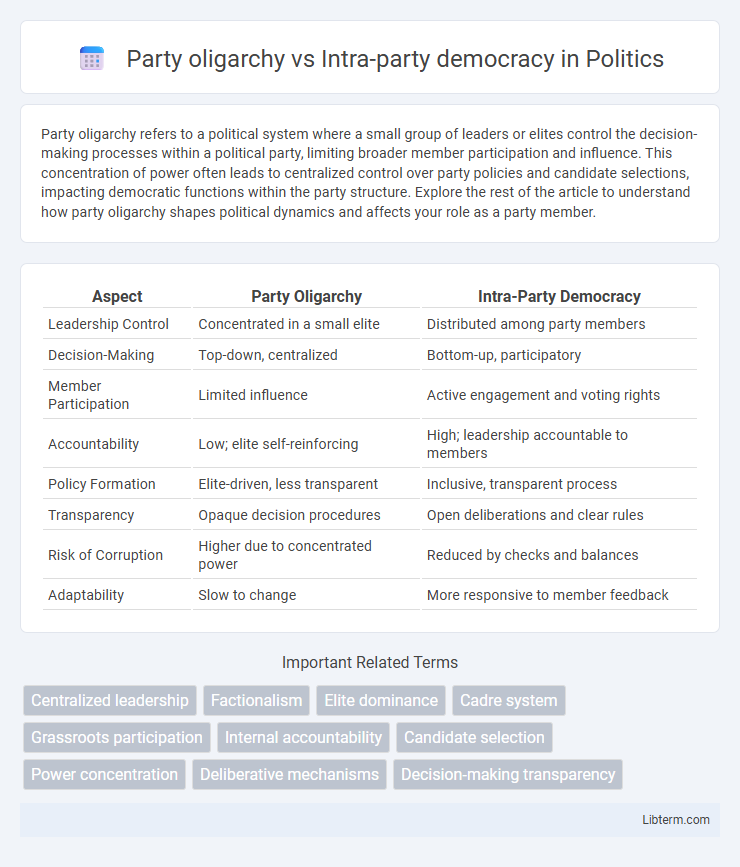Party oligarchy refers to a political system where a small group of leaders or elites control the decision-making processes within a political party, limiting broader member participation and influence. This concentration of power often leads to centralized control over party policies and candidate selections, impacting democratic functions within the party structure. Explore the rest of the article to understand how party oligarchy shapes political dynamics and affects your role as a party member.
Table of Comparison
| Aspect | Party Oligarchy | Intra-Party Democracy |
|---|---|---|
| Leadership Control | Concentrated in a small elite | Distributed among party members |
| Decision-Making | Top-down, centralized | Bottom-up, participatory |
| Member Participation | Limited influence | Active engagement and voting rights |
| Accountability | Low; elite self-reinforcing | High; leadership accountable to members |
| Policy Formation | Elite-driven, less transparent | Inclusive, transparent process |
| Transparency | Opaque decision procedures | Open deliberations and clear rules |
| Risk of Corruption | Higher due to concentrated power | Reduced by checks and balances |
| Adaptability | Slow to change | More responsive to member feedback |
Understanding Party Oligarchy: Definition and Origins
Party oligarchy refers to a political party system dominated by a small group of elite leaders who control decision-making processes and suppress dissent within the party. Originating from Robert Michels' "Iron Law of Oligarchy," this concept explains how even democratic parties tend to evolve into oligarchies due to centralized authority and organizational necessities. Understanding party oligarchy involves examining how elite control limits intra-party democracy and stifles ordinary members' participation in policy formation.
Intra-Party Democracy: Core Principles and Importance
Intra-party democracy emphasizes transparency, member participation, and accountability within political parties, ensuring decision-making power is distributed among members rather than concentrated in an elite few. It fosters pluralism by allowing diverse opinions and competitive elections for leadership positions, which strengthens party legitimacy and responsiveness to constituents. Upholding these core principles counters the dominance of party oligarchy, promoting internal cohesion and enhancing democratic governance overall.
Key Differences Between Party Oligarchy and Intra-Party Democracy
Party oligarchy centralizes decision-making power among a limited group of elites, often resulting in top-down control and limited member participation. Intra-party democracy promotes wider member involvement, with mechanisms such as elections, debates, and transparency ensuring collective decision-making. The key differences lie in power distribution, accountability, and inclusiveness within party structures.
Historical Examples of Party Oligarchies
Party oligarchies have historically centralized power within a select group of elite leaders, limiting broader member participation in decision-making processes. Notable examples include the Bolshevik Party under Lenin and Stalin, where control was consolidated by a tight inner circle, suppressing dissent and grassroots involvement. Similarly, the Chinese Communist Party maintained elite dominance through centralized committees, curtailing intra-party democratic practices to enforce policy uniformity and political stability.
Case Studies in Intra-Party Democratic Practices
Case studies in intra-party democratic practices reveal how political parties balance control with member participation, showcasing varying degrees of power dispersion. For instance, the German Social Democratic Party employs delegate voting and member consultations to foster transparency and grassroots influence, contrasting with the centralized decision-making seen in party oligarchies like Russia's United Russia. Such comparative analyses highlight the impact of intra-party democracy on policy responsiveness, leadership renewal, and political stability.
Impacts of Oligarchic Control on Political Parties
Oligarchic control in political parties concentrates decision-making power within a small, elite group, often leading to diminished internal democracy and reduced member participation. This centralization can result in policy stagnation, as the leadership prioritizes maintaining control over responding to grassroots demands. Such dynamics undermine party legitimacy, weaken accountability, and hinder the party's ability to adapt to changing political environments.
Benefits and Challenges of Intra-Party Democracy
Intra-party democracy enhances political accountability and member participation by allowing grassroots voices to influence candidate selection and policy decisions, fostering transparency and reducing the concentration of power seen in party oligarchies. However, this democratic approach can lead to internal conflicts, slower decision-making processes, and difficulties in maintaining party unity during elections. Balancing inclusivity with effective leadership remains a key challenge in ensuring intra-party democracy strengthens rather than weakens party cohesion and electoral success.
Effects on Candidate Selection and Policy-Making
Party oligarchy centralizes power within a small elite, resulting in top-down candidate selection that limits competition and tends to prioritize loyalty over public appeal, thereby narrowing policy options to elite preferences. Intra-party democracy promotes broader member participation in candidate selection, fostering greater accountability and responsiveness to grassroots demands, which often leads to more diverse and inclusive policy-making. The contrast between these structures shapes the balance between centralized control and democratic representation, directly influencing political legitimacy and policy outcomes.
Global Trends: Shifts Between Oligarchy and Democracy in Parties
Global trends reveal fluctuating patterns between party oligarchy and intra-party democracy, influenced by political culture, institutional frameworks, and societal demands. In regions with stronger democratic institutions, parties increasingly adopt intra-party democracy practices such as primaries and grassroots participation to enhance legitimacy and accountability. Conversely, in authoritarian or transitional regimes, party oligarchy remains dominant, concentrating power within elite factions and limiting broad-based member influence.
Strengthening Democratic Practices Within Political Parties
Party oligarchy often consolidates decision-making power within a small elite, limiting broader member participation and hindering transparency. Intra-party democracy fosters inclusive decision processes, encouraging active member engagement and accountability that strengthens overall democratic practices. Enhancing intra-party democracy promotes political pluralism, internal checks and balances, and responsive leadership.
Party oligarchy Infographic

 libterm.com
libterm.com